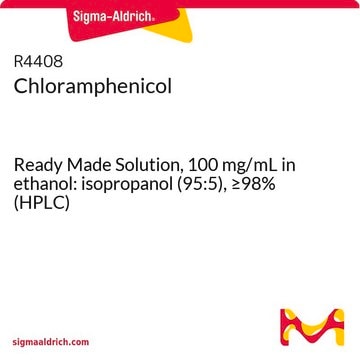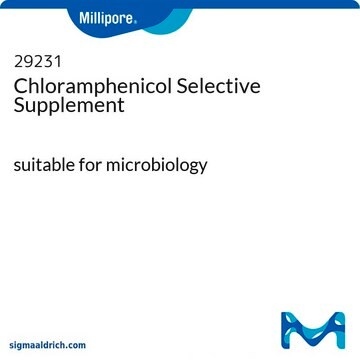220551
Chloramphenicol
Chloramphenicol, CAS 56-75-7, is a synthetic bacteriostatic antibiotic that inhibits the translation of RNA by blocking the peptidyltransferase reaction on ribosomes.
Sinônimo(s):
Chloramphenicol
About This Item
Produtos recomendados
Nível de qualidade
Ensaio
≥97% (by Assay)
forma
crystalline powder
fabricante/nome comercial
Calbiochem®
condição de armazenamento
OK to freeze
cor
gray to off-white
solubilidade
water: 2.5 mg/mL
methanol: 35 mg/mL
ethanol: soluble
Condições de expedição
ambient
temperatura de armazenamento
10-30°C
InChI
1S/C11H12Cl2N2O5/c12-10(13)11(18)14-8(5-16)9(17)6-1-3-7(4-2-6)15(19)20/h1-4,8-10,16-17H,5H2,(H,14,18)
chave InChI
WIIZWVCIJKGZOK-UHFFFAOYSA-N
Categorias relacionadas
Descrição geral
Ações bioquímicas/fisiológicas
trasnslation of RNA
Outras notas
Lu, J., and Jiang, C. 1993. Biochem. Biophys. Res. Commun.196, 12.
Saltarelli, M.J., et al. 1993. Virol.197, 35.
Holt, J.T. 1992. Ann. N.Y. Acad. Sci.660, 88.
Maniatis, T., et al. 1989. In Molecular Cloning, A Laboratory Manual, Second Edition. Cold Spring Harbor, NY, p. 1.6, A.6.
Informações legais
Palavra indicadora
Danger
Frases de perigo
Declarações de precaução
Classificações de perigo
Carc. 2 - Eye Dam. 1 - Repr. 2
Código de classe de armazenamento
11 - Combustible Solids
Classe de risco de água (WGK)
WGK 3
Certificados de análise (COA)
Busque Certificados de análise (COA) digitando o Número do Lote do produto. Os números de lote e remessa podem ser encontrados no rótulo de um produto após a palavra “Lot” ou “Batch”.
Já possui este produto?
Encontre a documentação dos produtos que você adquiriu recentemente na biblioteca de documentos.
Os clientes também visualizaram
Conteúdo relacionado
MILLIPLEX® genotoxicity assays enable high-throughput measurement of DNA damage, reducing time and cost.
Nossa equipe de cientistas tem experiência em todas as áreas de pesquisa, incluindo Life Sciences, ciência de materiais, síntese química, cromatografia, química analítica e muitas outras.
Entre em contato com a assistência técnica







